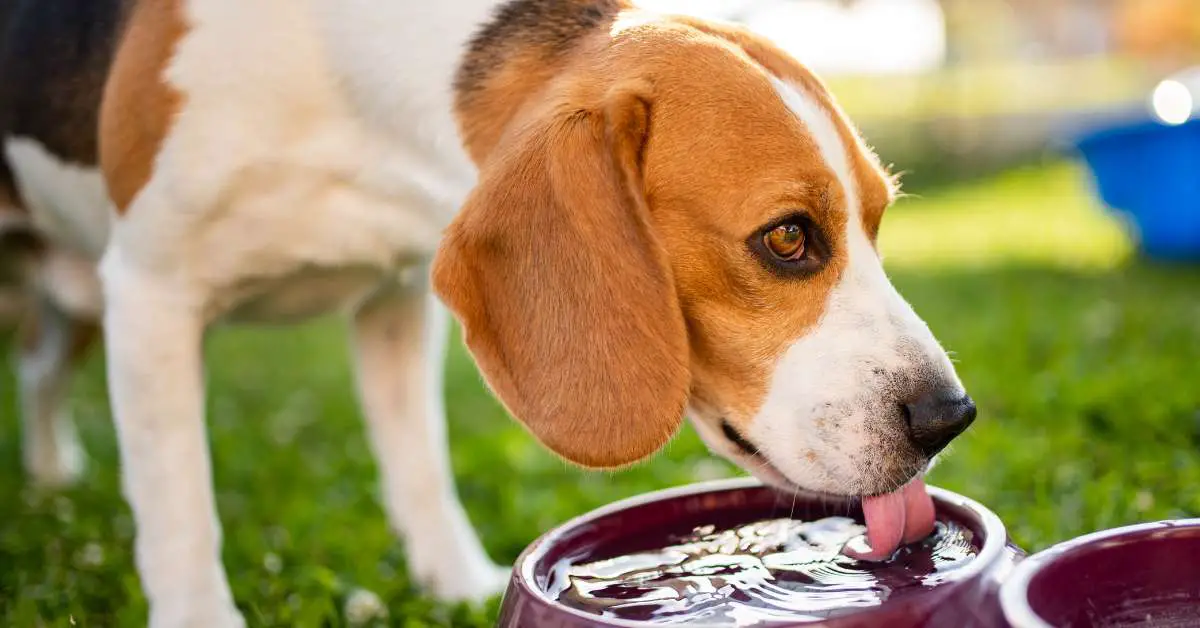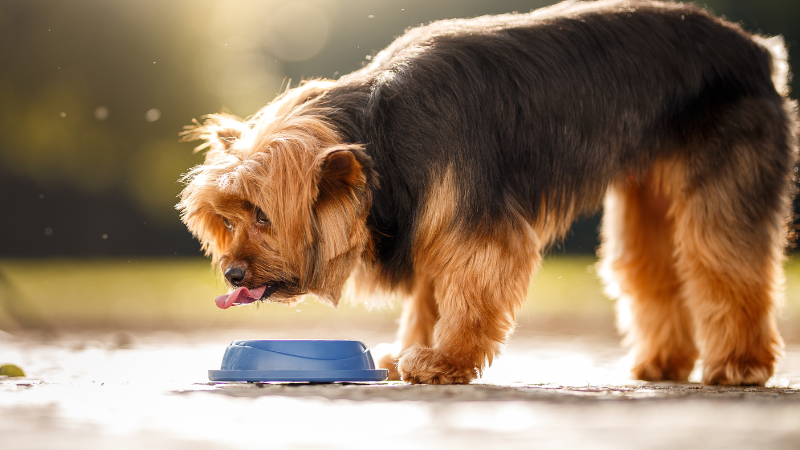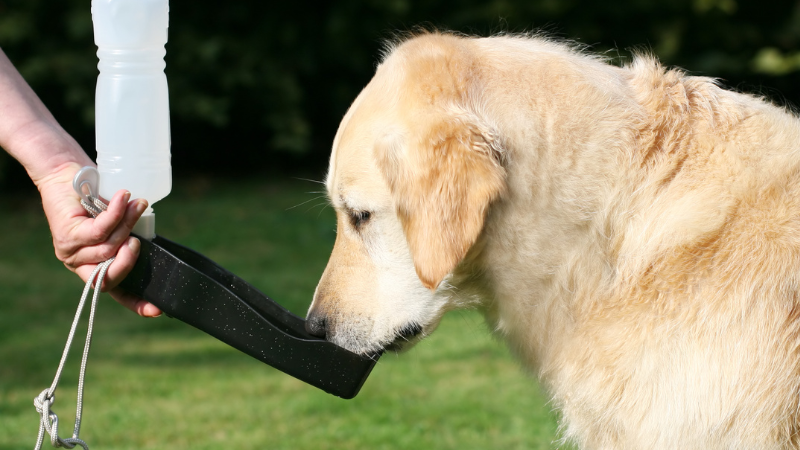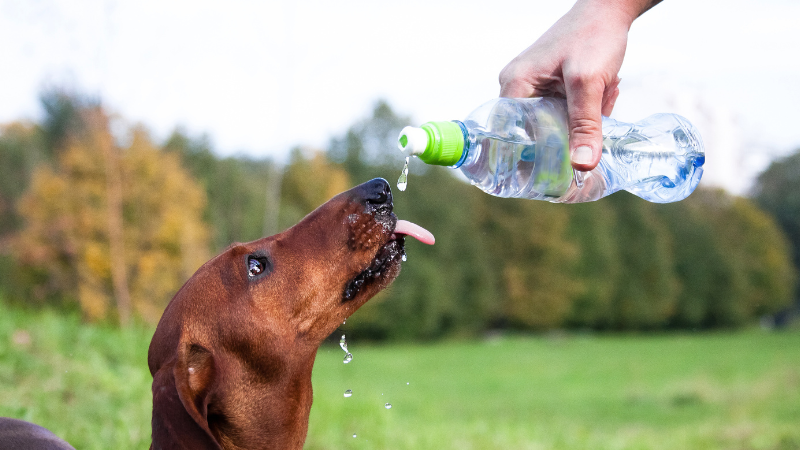How Much Water Should a Dog Drink? (A Complete Guide)

The health of a dog’s body as a whole relies heavily on the availability of water. Just like people, dogs have to drink enough water to maintain their optimal level of proper hydration and maintain their well-being and vitality.
But have you ever wondered, “How much water should a dog or cat drink anyway?” It is an important topic, and in this post, we will dig into the matter to offer you all the knowledge you need to maintain your furry buddy well-hydrated and healthy.
How Much Water Should a Dog Drink?
The quantity of water a dog should drink differs according to several criteria, including age, size, level of activity, and the circumstances outside. One ounce of water for every pound of body weight is a good rule for determining how much water a dog needs to drink.
If you have a dog that weighs 20 pounds, for example, it is recommended that they drink around 20 ounces of water daily.
On the other hand, this is only an approximate estimate, and it is always better to speak with your veterinarian to establish the precise amount of water consumption that is appropriate for your dog or pet’s water intake and individual requirements.

Puppies, lactating female dogs, and elderly dogs, as well as dogs with specific health issues, may have different water requirements than other dogs. Puppies and adult dogs who are nursing may need extra water.
Here you can study the effect of starvation on the daily consumption of water by the dog.
Why is Water So Important for Dogs?
A dog’s total health and well-being are directly influenced by its water consumption. It plays a vital role in several different biological processes, including digestion, circulation, body temperature, control, and waste elimination.
Water can lubricate joints, supply nutrients to cells, and wash toxins out of the body, all of which are essential bodily functions.
Due to the fact that dogs are unable to sweat as effectively as people, they must receive the adequate amount of water they require.
Dogs generally get rid of their body heat by panting, which can result in significant fluid loss. Dogs are susceptible to severe dehydration if they do not receive sufficient amounts of water, which can result in various health problems.
What are the Most Common Causes of My Dog Drinking More?
If your pet drinks much more water than normal, this excessive water drinking may be a symptom of a more underlying cause severe problem that needs to be addressed. Several different circumstances can cause increased thirst or water consumption in dogs.
Increased Physical Activity or Exercise
One of the most prevalent reasons is increased physical activity or exercise, which results in greater water loss through perspiration and breathing.
Hot Temperature
The warmer temperature is another potential contributor to the problem. In hotter conditions, dogs have a greater tendency to consume more water in order to replenish the additional fluid that they lose through increased panting.
Diseases
In addition, a dog’s thirst may be exacerbated by certain underlying medical condition/medical diseases such as diabetes mellitus, renal illness, or Cushing’s disease.
Fact: If you give your pup only dry food (especially on hot days), his water intake may increase drastically, and he may need water every few hours.

How Can You Tell if Your Dog Needs More Water?
You must pay close attention to the amount of water your dog consumes and closely monitor any changes in their drinking patterns.
If your little dog drinks more water than normal, this may be a sign that they require more hydration than they are currently getting from their diet. In addition to dry gums and sunken eyes, other symptoms of dehydration in dogs include lethargy, loss of appetite, lethargy, and dark yellow urine.
You can also send some of your dog’s urine samples to your vet. Your vet can perform some urine tests via some chemical process to inform you about your dog’s hydration level.
Ensure that your dog has access to a water bowl with enough fresh, clean water to drink daily in order to maintain a healthy hydration level. It’s a good idea to scatter water bowls about your home, especially if you have a large home with multiple floors or if you have older dogs or multiple pets.
In addition, remember to bring water with you whenever you take your larger dogs on outings in the great outdoors or on extended walks.
Why Your Dog Might Drink Less Water Sometimes?
Even though canines need to consume adequate water daily, there may be situations when you observe that your four-legged friend is drinking too much or drinking so much water than typical.
This should be cause for alarm, but there are a few other explanations for why a full dog’s water intake and consumption might decrease.
Other Explanations
A shift in the weather is one of the most typical explanations. Dogs may naturally drink less water during winter because they do not lose as much fluid via panting as they do during warmer months. Similarly, their water consumption during hot weather may drop if your dog is less active or a healthy dog spends more time indoors.
Alterations in dietary habits or homemade diet are still another potential explanation. Your dog may be getting some of the water they need from their canned food if you have recently changed their diet or given them new treats.
Some wet dog diets include a higher percentage of moisture which results in a lower intake of dry food and your dog drinking less water overall.
Anxiety or stress can also impact a dog’s water intake and cause it to drink less water. Emotional shifts may happen to dogs, just like they can happen to people, and these shifts can influence how much and how often a dog eats and drinks.
Your dog may drink less water temporarily if they are going through a stressful phase, such as relocating to a new house or suffering from separation anxiety.
Last but not least, some dogs are simply more particular than healthy dogs about the type of water they drink. It’s possible that they like bottled or filtered water over the water from the tap.
They could also choose drinking too much water from a cooler. If you have reason to believe this is the situation, you may test this theory by providing your dog with various water bowls to determine which one he prefers.
Here is the complete guide on a dog’s thirst and its inhibition on wet food in the stomach.

FAQs
How Can I Check if My Dog Is Dehydrated?
A mildly dehydrated dog may be identified with a few easy checks. You should carefully lift the skin that is located on the back of your dog’s neck, and then you should let it go. It may be a symptom of dehydration if the skin stays tent-like or if it takes longer than usual for the skin to return to its normal position.
You may also inspect the condition of their gums; healthy gums should be pink and moist. If the gums are dry or sticky, this might indicate that the body lacks water.
Is It Possible for Your Dog to Consume Too Much Water?
Although dogs need to maintain a healthy level of hydration, they can consume too much water or try to eat dog ice cubes. Polydipsia is the name used in veterinary medicine to describe this disorder.
Consuming an abnormally large amount of water may indicate a more serious underlying health condition, such as diabetes, renal illness, kidney disease, liver disease, or hormone abnormalities.
It is in your best interest to seek the advice of your veterinarian if you discover that your dog is drinking too much water or is exhibiting any other peculiar symptoms.
Can Dogs Drink Tap Water?
Most of the time, a dog won’t have any problems if they drink water from the tap. In most cases, tap water is safe for most dogs to drink since it has already been treated to eliminate germs and other toxins.
On the other hand, certain dogs may have sensitivities or allergies to particular chemicals or minerals that are found in tap water.
You might try giving your dog filtered or bottled water as an alternative to tap water if you have reason to believe that he or she is sensitive to the water from the tap.
What Happens if a Dog Doesn’t Get Enough Water?
A dog can get dehydrated if they don’t get enough water, or eating wet food, which can have significant repercussions for their health.
Dehydrated dogs may experience lethargy, loss of appetite, dry skin, sunken eyes, and a reduction in the amount of urine they produce.
In extreme circumstances, it can fail many organs and even death. To keep your own dog’s health from being dehydrated, you must provide it with uncontaminated, fresh water at all times.

Final Words
It is essential for your dog’s general health and well-being that you provide them with a proper amount of fresh water daily.
The basic rule of one ounce of water per pound of body weight is suitable as a starting point. Still, it is also vital to take into consideration characteristics such as size, age, activity level, and weather conditions.
You can assist your dog in being well-hydrated and thriving by paying attention to their drinking habits and ensuring they have access to clean water.
Remember that you should talk to your vet if you have any concerns about the amount of water your dog is drinking or if you see any changes that are not typical to receive additional information and specific suggestions.
Your dog’s particular requirements will be evaluated by your veterinarian, who can also diagnose and treat any underlying health conditions preventing them from drinking enough water.
